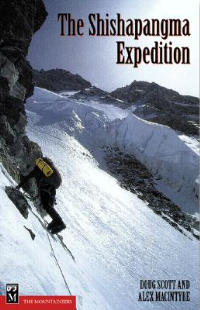 Shishapangma Expedition
Shishapangma Expedition

The avalanche deaths of climbers Alex Lowe and Dave Bridges have renewed attention to Tibet's 8,027-meter Shisha Pangma and past climbs on its sheer, glacial faces. One of the more infamous is the 1982 ascent by Alex McIntyre, Doug Scott, and Roger Baxter-Jones, who summited from the unclimbed southwest face. Open to foreign tourists for less than four years, Tibet had been hobbled by the military presence of the Chinese, and the resulting communist bureaucratic minefield proved more formidable, at times, than the mountain. For two years, Scott, McIntyre, Nick Prescott, Elaine Brook, and Paul Braithwaite struggled with paperwork and revolving regulations. Meetings with mountaineering officials in Lhasa turned into maddening nights of drinking rancid tea and arguing through interpreters. Food was scarce and frequently spoiled, the yaks issued to the team were sick, and personalities in the group clashed intensely by the time they reached base camp.
By the acclimatization climb to Nyanang Ri, at 7,071 meters, two of the original six team members were on their way out. "I'm sorry, but charity ends at 5,000 meters," McIntyre tells Nick Prescott, the least experienced of the climbers. Indeed, McIntyre is on a summit mission to be stalled by no one, and Scott, in his trademark philosophical approach to mountaineering, tries to make peace between the group's remaining members. But a second acclimatization climb on 7,445-meter Pungpa Ri hastens the division, as Scott questions his own age and lack of ice skills, while McIntyre and Baxter-Jones leave him in their frozen dust. It isn't until their summit attempt that harmony seems possible and the three set out in ideal conditions. By morning, however, Scott is coughing up blood, Baxter-Jones is vomiting his meal of rotten fish, and McIntyre, who is irrepressibly itchy to move ahead, barely dodges a falling rock (an ominous omen, as he would die from a rock strike only two months later). But the trio still manages to summit flawlessly in light alpine form, lending support to Prescott's wise summation: "Mountains are all about decisions. The climbing is the easy part."
Anyone looking for an Annapurna-style drama may be disappointed with this straightforward account told in interchanging entries by McIntyre and Scott, but readers who savor a realistic description of the misery, personal discord, and sudden catharsis that define high-altitude climbing will feel duly sated by Scott's wizened reflections and McIntyre's technical detail.
|
|
This adventure classic captures everything from the historical to the deeply personal in a gripping account of an ambitious first ascent of the Southwest Face of Shishapangma. As Alex MacIntyre describes it, "To climb it became an ambition, but not just to climb it, we had to make the ascent with style, as light, as fast, as uncluttered as we dared, free from umbilical cords and logistics, with none of the traditional trappings of a Himalayan climb. The wall was the ambition, the style became the obsession."
Placing the expedition into a historical context, Doug Scott presents a wealth of historical detail about the region while Alex MacIntyre provides a unique commentary on the "big peak" way of life-from the frenzied preparations to the clashes of personality, the affection, and the humor |